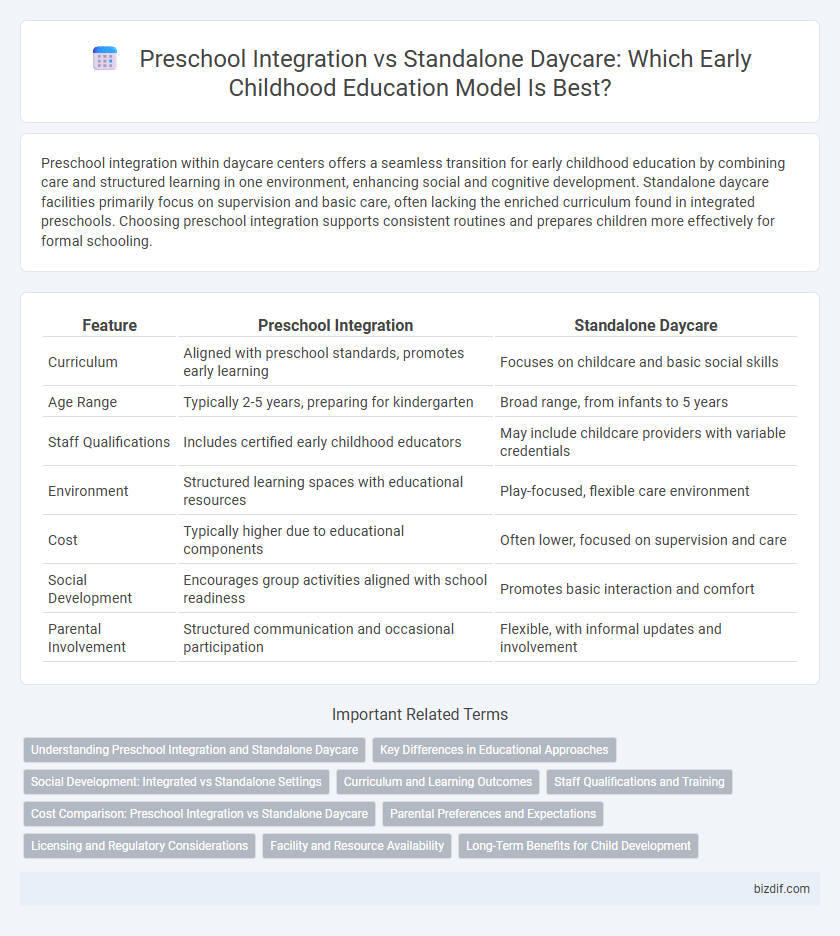Preschool integration within daycare centers offers a seamless transition for early childhood education by combining care and structured learning in one environment, enhancing social and cognitive development. Standalone daycare facilities primarily focus on supervision and basic care, often lacking the enriched curriculum found in integrated preschools. Choosing preschool integration supports consistent routines and prepares children more effectively for formal schooling.
Table of Comparison
| Feature | Preschool Integration | Standalone Daycare |
|---|---|---|
| Curriculum | Aligned with preschool standards, promotes early learning | Focuses on childcare and basic social skills |
| Age Range | Typically 2-5 years, preparing for kindergarten | Broad range, from infants to 5 years |
| Staff Qualifications | Includes certified early childhood educators | May include childcare providers with variable credentials |
| Environment | Structured learning spaces with educational resources | Play-focused, flexible care environment |
| Cost | Typically higher due to educational components | Often lower, focused on supervision and care |
| Social Development | Encourages group activities aligned with school readiness | Promotes basic interaction and comfort |
| Parental Involvement | Structured communication and occasional participation | Flexible, with informal updates and involvement |
Understanding Preschool Integration and Standalone Daycare
Preschool integration combines early childhood education with daycare services, offering structured learning environments alongside flexible care hours, which supports cognitive and social development in children aged 3 to 5. Standalone daycare focuses primarily on supervision and basic care for infants to preschoolers, emphasizing safety and social interactions without a formal curriculum. Understanding these distinctions helps parents choose programs aligned with their child's developmental needs and family schedules.
Key Differences in Educational Approaches
Preschool integration in daycare centers emphasizes structured early childhood education with a curriculum aligned to developmental milestones, fostering cognitive, social, and emotional growth. Standalone daycare primarily focuses on supervision and basic care, with less formalized learning activities and more play-based interaction. Integrated programs often employ certified educators and standardized assessments, whereas standalone daycare may rely on caregivers without specialized training in early childhood education.
Social Development: Integrated vs Standalone Settings
Preschool integration in daycare settings enhances social development by encouraging interactions among diverse age groups, fostering empathy and cooperative play. Standalone daycare centers often provide peer-focused socialization but may limit exposure to varied developmental stages that promote adaptability. Research indicates children in integrated preschools exhibit improved communication skills and emotional intelligence compared to those in isolated daycare environments.
Curriculum and Learning Outcomes
Preschool integration in daycare centers offers a structured curriculum aligned with early childhood education standards, enhancing cognitive, social, and emotional development through age-appropriate activities. Standalone daycare programs often emphasize care and supervision over academic learning, which may result in less consistent development of foundational skills like literacy and numeracy. Research shows integrated preschool-daycare models improve school readiness and long-term educational outcomes compared to non-integrated daycare settings.
Staff Qualifications and Training
Preschool integration in daycare settings typically requires staff to possess advanced qualifications such as early childhood education degrees and specialized training in developmental curricula to support school readiness. Standalone daycare centers often prioritize certifications in childcare, CPR, and health and safety but may not mandate formal early education credentials. Investing in continuous professional development enhances staff capabilities to address diverse age groups and fosters a nurturing learning environment.
Cost Comparison: Preschool Integration vs Standalone Daycare
Preschool integration often reduces overall childcare expenses by combining early education and care under one program, whereas standalone daycare typically incurs higher costs due to separate fees for childcare and early education. Families may benefit financially from integrated preschools through bundled pricing models, which streamline payments and reduce duplication of services. Cost comparison reveals that integrated programs offer greater value by minimizing additional costs such as transportation and separate enrollment fees common in standalone daycare centers.
Parental Preferences and Expectations
Parents often prefer preschool integration within daycare settings for its seamless blend of early education and supervised care, promoting cognitive and social development simultaneously. Expectations include qualified educators, structured learning curricula, and age-appropriate activities that align with school readiness goals. Standalone daycare appeals to parents prioritizing flexible hours and a nurturing environment without formal academic pressure.
Licensing and Regulatory Considerations
Preschool integration within daycare settings often requires adherence to dual licensing standards that cover both early childhood education and childcare regulations, ensuring comprehensive compliance with state and federal mandates. Standalone daycare centers primarily follow childcare licensing guidelines, which may be less stringent than those imposed on preschools but still focus on safety, staff qualifications, and child-to-staff ratios. Understanding the nuances in licensing requirements is crucial for operators to maintain legal certification, secure funding, and provide high-quality care aligned with regulatory frameworks.
Facility and Resource Availability
Preschool integration in daycare centers typically offers enhanced facilities such as age-appropriate classrooms, educational materials, and outdoor play areas designed to support early childhood development. Standalone daycare facilities may have limited resources focused primarily on supervision and basic care, lacking specialized learning environments or trained educators for early learning. Access to comprehensive educational resources and structured activities is more prevalent in integrated settings, promoting cognitive and social growth alongside childcare.
Long-Term Benefits for Child Development
Preschool integration within daycare settings fosters enhanced cognitive and social-emotional development by providing early exposure to structured learning environments and peer interaction. Standalone daycare programs often emphasize basic care and socialization but may lack the comprehensive curriculum that supports school readiness and language acquisition. Long-term benefits of integrated preschools include improved academic performance, better problem-solving skills, and increased adaptability in diverse learning contexts.
Preschool integration vs standalone daycare Infographic

 bizdif.com
bizdif.com